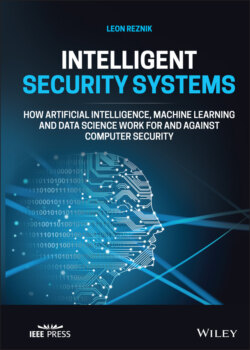Читать книгу Intelligent Security Systems - Leon Reznik - Страница 16
I.4 Book Organization and Navigation
ОглавлениеThe book consists of six big chapters (see Figure I.1) covering the specialized topics including:
1 review of the modern state of the computer security and artificial intelligence, machine learning, and data science applications in the area;
2 firewall design;
3 intrusion detection systems;
4 anti‐malware methods and tools;
5 hacking activities, attack recognition, and prevention;
6 adversarial attacks against AI‐based computer security tools and systems.
Figure I.1 Book organization.
The book will be accompanied by presentation slides as well as samples of exercises, test and exam questions, research, and tool assignments.
From the computer security perspective, the book moves a reader from reviewing the current situation through the traditional first line of defense (firewalls) and the second line of defense (intrusion detection systems) to the discussion of the modern malware families and anti‐malware protection and toward hacker’s and ordinary user’s profiles and typical activities with finishing up by discussing the privacy protection systems and adversarial attacks using machine learning techniques.
From the artificial intelligence perspective, the book starts with the review of artificial intelligence, machine learning, and data science techniques and technologies, then discusses the logic of the rules‐based and expert systems, and proceeds with machine learning and data science applications in the computer security domain. It presents multiple algorithms and methods, especially focusing on artificial neural networks, including shallow learning models, deep learning procedures, and generative adversarial networks.
While the book content covers major security mechanisms as well as intelligent techniques they employ, they are distributed over all chapters. In respect to the techniques generally, the book moves from older (and possibly, simpler) methods to newer (and possibly, more sophisticated) ones. However, each chapter is self‐contained and could be studied separately from others.
In particular:
Chapter 1 discusses the basic concepts of computer security as well as the taxonomy and classification of the fundamental algorithms in the domains of artificial intelligence, machine learning, and data science in relation to their applications in computer security. It reviews the sources of security threats and the attacks, concentrating on the area of IoT and wireless devices, as well as examines the possible protection mechanisms and tools. The module provides a general classification of intelligent approaches and their relationship to various computer security fields. It focuses on an introduction of the major intelligent techniques and technologies in computer security, such as expert systems, fuzzy logic, machine learning, artificial neural networks, and genetic algorithms. While presenting multiple techniques, the text emphasizes their advantage in comparison to each other as well as the obstacles in their further progress. Short algorithm descriptions and code examples are included.
Chapter 2 introduces a firewall as the first line of defense mechanism. It provides its definition, discusses the functions, possible architectures, and operational models, concentrating on presentation of their advantages and drawbacks. It includes the step‐by‐step guide to firewall design and implementation process ranging from planning to deployment and maintenance. The major emphasis in this chapter is placed on using rules to set up, configure, and modify the firewall’s policy. Both generic and specific rules are discussed as well as their formulation and editing with firewall tools. Substantial rules design principles and conflict avoidance and resolution are presented.
Chapter 3 develops knowledge and practical skills on intrusion detection and prevention systems (IDS) design, their analysis, implementation, and use. It presents IDS definition, discusses their goals and functions as well as their progress from the historical perspective. It advances reader’s design and analysis skills in the computer security domain by discussing artificial intelligence and machine learning techniques and their application in IDS design and implementation as well as in classifying IDS systems, evaluating an IDS performance, choosing the IDS design tools and employing them in practical design exercise. Algorithm and code examples are provided.
Chapter 4 discusses malware types, its detection and recognition techniques and tools. It provides an extensive classification of various malware and virus families, discusses their taxonomy, basic composition, and comparison between them. Beyond pure malware examples, it reviews spam and software vulnerabilities too. Multiple real life cases and examples are provided. Then, it moves to presenting malware detection principles, algorithms and techniques, and anti‐malware tools and technologies. Their examples and use cases are included.
Chapter 5 starts with discussing how hacker’s demography and their culture have been changing over the last years. Then, it proceeds with presenting hacking attacks, techniques, and tools as well as anti‐hacking protection mechanisms. In the second part, it moves to the ordinary user’s profiles and authentication. Here, we show how to employ data science and statistical approaches to find out and analyze user’s characteristics and their influence on the security level of their computer practice. The module presents the computer device security evaluation. It discusses how to conduct analysis, observations, results, and recommendations for users to improve their overall security practices and the security of their devices. Also, it examines the hacking web fingerprinting attacks against the privacy protection TOR technology that utilizes machine learning as well as possible protection mechanisms. Examples and use cases are included.
Module 6 introduces novel adversarial machine learning attacks and their taxonomy when machine learning is used against AI‐based classifiers to make them fail. It investigates a possible data corruption and quality decrease influence on the classifier performance. The module proposes data restoration procedures and other measures to protect against adversarial attacks. Generative adversarial networks are introduced, and their use is discussed. Multiple algorithm examples and use cases are included.
